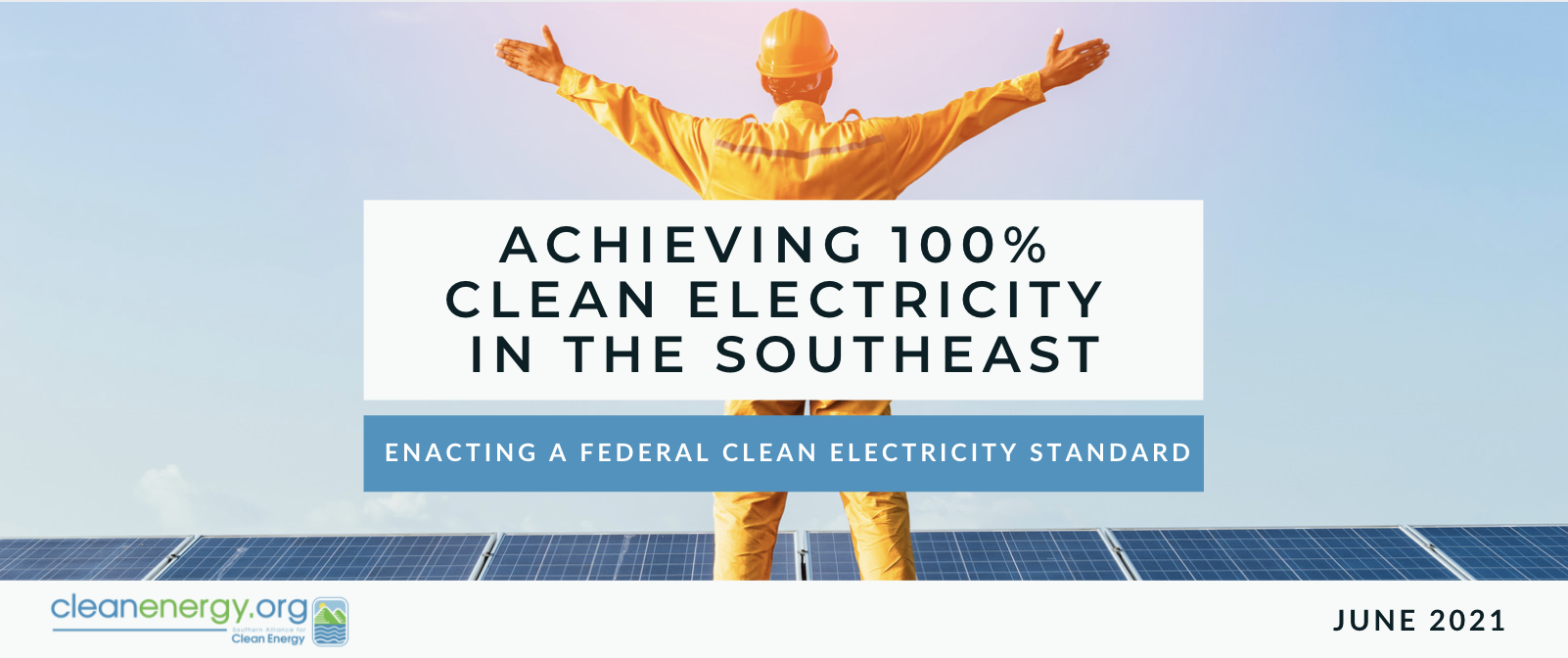A new report, “Achieving 100% Clean Electricity in the Southeast: Enacting a Federal Clean Electricity Standard,” released today by the Southern Alliance for Clean Energy (SACE) analyses multiple pathways for some of the biggest utility systems in the nation – Tennessee Valley Authority (TVA), Southern Company, NextEra, and Duke Energy – to achieve 100% clean electricity by 2035.
The report shows that utility sector decarbonization is achievable through a federal 100% Clean Electricity Standard (CES), which is a critical element of the Biden administration’s infrastructure proposal currently being debated in Congress. A CES would require that the percentage of U.S. electricity coming from zero-carbon sources increases until it reaches 100% by 2035, thereby serving as the cornerstone for our broader clean energy transformation.
The timing is urgent. As President Biden meets with world leaders and recommits the U.S. to leading on combatting climate change, decarbonizing our power sector would set us on a path to the drastic reductions in greenhouse gas emissions that science tells us is needed in order to avert the worst impacts of climate change.
Clean or renewable electricity standards are already law in more than 30 states and territories and have effectively driven low-cost power sector decarbonization, while stimulating local investment. The role that these four electric utilities in the Southeast are – or aren’t – playing in decarbonizing the power supply is more critical than ever for the U.S. to achieve a carbon-free power sector by 2035 through a federal Clean Electricity Standard.
On Wednesday, June 16, and Thursday, June 17, SACE’s policy staff will host webinars focusing on pathways to 100% clean electricity for each of the utilities examined in the report – Duke Energy, NextEra, TVA, and Southern Company – including:
- What a federal Clean Electricity Standard is and how it could be key to kickstarting aggressive decarbonization
- Multiple pathways with a different power generation mix for each utility to reach net-zero carbon emissions
- How distributed resources like rooftop solar and energy efficiency are key to decarbonizing
- Descriptions of the method used to develop and test each pathway to clean electricity
Register for one or more of the following webinars Wednesday, June 16, and Thursday, June 17:
- Duke Energy: Wednesday, June 16, 11 AM – 12 PM ET
- NextEra: Wednesday, June 16, 3 PM – 4 PM ET
- Tennessee Valley Authority: Thursday, June 17, 11 AM – 12 PM ET
- Southern Company: Thursday, June 17, 3 PM – 4 PM ET
Download the report: “Achieving 100% Clean Electricity in the Southeast: Enacting a Federal Clean Electricity Standard.”
Read an excerpt of the corresponding blog post below, or the entire post here: Report: Achieving 100% Clean Electricity in the Southeast.
Report: Achieving 100% Clean Electricity in the Southeast
by Maggie Shober, Director of Utility Reform
A new SACE report shows not only that is it possible for the four largest utilities in the Southeast to achieve 100% clean electricity, but there are several pathways to get there. A variety of different energy technologies and programs can be deployed to reach this goal. The key takeaway is that we need to start now.
WHAT IS A CLEAN ELECTRICITY STANDARD?
A clean electricity standard is a policy that requires utilities to use clean energy resources to generate a minimum portion of all energy by a certain date. Since the first renewable standard was passed in Iowa in 1983, states and utilities across the U.S. have a lot of experience with this kind of policy. As part of federal climate action, the Biden administration and several members of Congress have proposed different versions of a Clean Electricity Standard (CES) that achieves 100% clean electricity by 2035. SACE has called for the Tennessee Valley Authority (TVA) to lead the way by getting to 100% clean electricity by 2030.
PATHWAYS TO A CES IN THE SOUTHEAST
To help us understand what 100% clean electricity would look like here in the Southeast, SACE staff developed pathways to meet a CES policy for our region’s four largest utility companies: TVA, Southern Company, Duke Energy, and NextEra (which owns Florida Power & Light and Gulf Power).
Our primary pathway is focused on distributed energy resources (DERs). We found that with significant and sustained investments in DERs like energy efficiency and rooftop solar, these utilities can achieve a customer-oriented pathway to clean electricity. In fact these two resources, energy efficiency and rooftop solar, could meet approximately one third of all electricity needs for these utilities by 2035. In addition to these distributed resources, these successful pathways will also include wind power, large-scale solar, and energy storage. See the charts below for a snapshot of how this particular pathway to 100% clean electricity compares to current utility plans …
Continue reading the blog post here.
Register for one or more of the report webinars on June 16 and 17 in the links listed above.
###
About Southern Alliance for Clean Energy
Since 1985, Southern Alliance for Clean Energy has worked to promote responsible and equitable energy choices to ensure clean, safe, and healthy communities throughout the Southeast. Learn more at cleanenergy.org.



